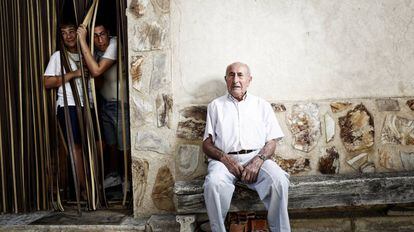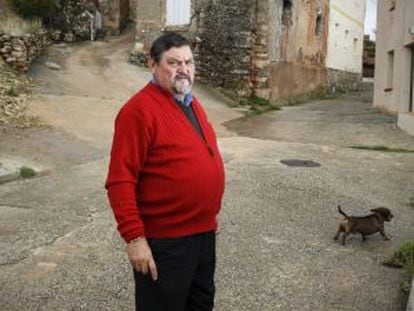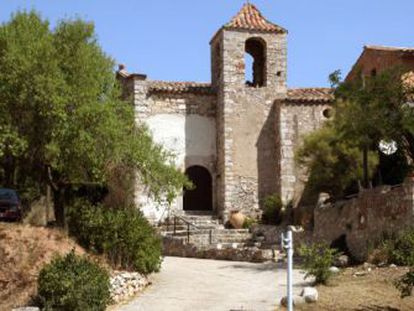An old Spanish village has a strategy to attract new talent
With just 32 residents, Olmeda de la Cuesta is offering cheap plots of land to attract more incomers

The busiest time of the average day in the tiny community of Olmeda de la Cuesta is when the bread van comes with a fresh batch loaves, buns and cakes at 9 a.m. The village, tucked away in the Alcarria region of the central province of Cuenca, has the oldest population in Spain. The youngest inhabitant is the bailiff, who is 49, while the oldest is 94. “He’s neither alive nor dead,” says his eighty-something neighbor Asunción López, who doesn’t beat about the bush. “I talk to the walls here because there’s no one else to talk to.”
But something is afoot in this town of 32 residents. Thanks to an initiative by Mayor José Regacho of the Socialist Party (PSOE), 14 plots of land have been put up for sale for next to nothing in a bid to revive this corner of rural Spain. Among those taking advantage of the scheme are former residents wanting a second home; others have come to start a new life, like the chef from Iran, the engineer from Venezuela and the plasterer from Poland. In Olmeda’s favor, it is just two hours drive from Madrid.
Five years ago, this corner of the Cuenca region of Alcarria looked like a pile of rubble, with thistles fast replacing the 500 people who once lived here. “This place was on the road to being finished,” says Regacho, the son of the former mayor Natalio Regacho. “But we stopped it from going under.”
It’s three in the afternoon and Olmeda de la Cuesta is quiet. Only cats stroll through the narrow streets of colored houses
The turning point came with the opening of a community center, which is basically a bar with a room at the back, used to show films or host a dance – events that attract as many as 150 people from outlying communities. “The locals are old and aren’t into raves but when they put on a paso doble, there’s not a soul left sitting,” he laughs
Mariela López, 61, is the first of the new residents to finish her home, a three-story house that looks out over a small gorge. “I actually preferred a different plot but I chose this one because it’s where my old home was,” she says.
The morning she moved in, she put on a record by Natalie Cole and called her husband. “I told him that I had dreamed of listening to this CD in my own home in Olmeda for 10 years and that now my dream had come true,” she says, clearly moved.
The first floor resembles an artist’s studio. There are no chairs, just paints and crayons and rubbers strewn around the room. A number of religious figures stand on waxed paper on a table at the center, part of a project she is carrying out for the church in this village she hopes to move to when her husband retires and they can leave their current home in Zaragoza for good.
The Picó-Sandovals were also looking for an alternative way of life when they stumbled upon the mayor’s offer. Living in Venezuela, they wanted to move to Spain and Mayra had spent two years trying to find a way to make their dream a reality. Then one day she read that Olmeda de la Cuesta was offering plots of land for €15 per square meter, and so she wrote to the mayor, a correspondence that went on for a couple of months.
“He told me it was a place to relax, not work,” says the civil engineer whose husband is an industrial engineer. But as she plans to making a business from selling cakes, they came anyway. “Although my husband has worked all his life in a very different field, he knows a lot about the market and we realized we could try to make a living at it,” she explains. Meanwhile, her partner Fernando has been working on a project to reconstruct some of the caves close to the village that could be turned into a museum.
The mayor defines the new residents as people who have an environmental approach to life, and who are trying to set up a business rather than look for a job. “They are talented people who will give the village a stable population in the medium and long-term,” he says.
The artistic endeavors of Mariela López and Fernando Picó are buttressed by Vicente García, an artist trying to bring a different flavor to an area traditionally linked to agriculture and construction. Using EU grants, he has built a sundial, a wall etched with the village’s history and a copper viewing point inspired by ocean waves.
“Young people don’t come here because of the lack of opportunity,” he says. “The last generation to be born here are now 50. You have to offer them something different such as the possibility of owning their own home at the age of 30.”
This week García is getting together with a group from Chile that is launching a sustainable agriculture initiative and also with a group who want to build with traditional adobe bricks. “This town has to be prepared to be a guinea pig,” he says.
Another of García’s goals is to turn derelict fields into urban vegetable gardens. “You might not see it, but this town could become a major tourist attraction,” he says.
By now, it’s three in the afternoon and Olmeda de la Cuesta is quiet. Only cats stroll through the narrow streets lined with colored houses. Natalio Regacho, 82, is having lunch. During his 34 years as mayor, there were up to 200 people living here. He says he misses the people. “Everyone left,” he explains. “And now they don’t want to come back.”
He sighs at the thought that one day there might be a bakery again here. If that happens, 9 a.m. will no longer be the busiest time of day and Olmeda de la Cuesta will once again seem like a real village.
English version by Heather Galloway.
Sign up for our newsletter
EL PAÍS English Edition has launched a weekly newsletter. Sign up today to receive a selection of our best stories in your inbox every Saturday morning. For full details about how to subscribe, click here












































